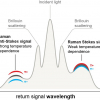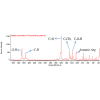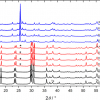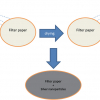Howell G.M. Edwards
Division of Chemical and Forensic Sciences / University Analytical Centre, School of Life Sciences, University of Bradford, Bradford BD7 1DP, UK. E-mail: [email protected]
Raman spectroscopy characterisation of the only remaining sail from HMS Victory at the battle of Trafalgar, and the spectroscopic monitoring of the effect of several degradative processes conducted in the laboratory on a selected modern replicate in order to simulate the aged material for the eventual sympathetic restoration of the historical artefact.
Introduction
There are now many examples in the literature where vibrational spectroscopy has been applied to problems in art and archaeology. It has been used to determine analytically pigment composition, the presence of unrecorded restorations, the characteristic palette and preparative procedures adopted by artists, damage caused through biological deteriorative agencies, and to reveal the presence of fake artefacts and works of art.1–4
The case-study presented here provides an example of a forensic conservation exercise on a unique historical relic, which was necessary not only because of its bad state of repair upon its re-discovery, but also for the need to ascertain what the damage was scientifically so that steps could be taken to undertake its conservation using appropriately aged modern materials for the sympathetic restoration of the artefact for its eventual display. This particular course of action had arisen because of the rather complex nature of the deterioration suffered by the artefact, through both natural environmental exposure and also from the additional and very obvious deliberate damage caused by human agency. The requirement was for a restorative repair to be undertaken with modern simulates of the ancient materials which had been aged, so that the stress of the repair work on the restored artefact would be minimal. Clearly, the first objective in this exercise was the analytical spectroscopic characterisation of the relict material, followed by the spectroscopic monitoring of the effect of several degradative processes conducted in the laboratory on a selected modern replicate in order to simulate the aged material for the eventual sympathetic restoration of the historical artefact.
The relict artefact under study was the foretopsail of HMS Victory which was carried into battle on 21 October 1805, when Admiral Lord Nelson led a numerically inferior force against the combined might of the Franco–Spanish naval alliance off Cape Trafalgar in what is now appreciated as the last great naval engagement5 between “fighting sail”. Sixty battleships in the opposing navies fought an intense action on that day and the Victory sail, as it is now known, was the only sail to survive the ferocity of the battle. Several stratagems were adopted in that engagement, the most notable being that of Nelson who divided his force into a Weather Column led by himself in the Victory and a Lee Column under the command of Admiral Lord Collingwood in the Royal Sovereign. The Franco–Spanish fleet were under the command of Admiral Villeneuve in the Bucentaure and Admiral Gravina in the Santissima Trinidad, which was the most powerful ship on either side, being a four-decked first-rater with 144 guns. Nelson and Collingwood attacked the enemy line orthogonally at the two points represented by the command battleships of the French and Spanish Admirals but in doing so they were forced to receive intense bombardment from the Franco–Spanish fleet for about thirty minutes before they were able to respond with broadsides into the unprotected flanks of the Bucentaure and Santissima Trinidad. Franco–Spanish naval strategy was to fire their broadsides “on the roll”, which caused a disproportionate damage to the masts and rigging of the enemy ships; hence, most of the British battleships that survived the action were completely dismasted.
That the Victory sail survived as the sole example of its kind from the 37 sails that she carried into the battle is ascribed to the foretopmast being brought down by gunfire from the Neptune very early in the action as the Victory penetrated the enemy line of battleships. This is depicted in the painting by J.M.W. Turner of the Battle of Trafalgar commissioned by King George IV in 1825 and shown in Figure 1. Although Turner’s landscape paintings were generally highly appreciated at that time, this particular work, the largest canvas he had ever painted, brought him severe criticism from survivors of the action; it can be best considered as a montage of events that occurred that day, including the breaking of the line by the Victory, the sinking of the Redoubtable, the capture of the Bucentaure, the burning of the Achilles, and very appropriately for the subject under study here, the bringing down of the foretopmast and sail of the Victory whose sailors were able to cut it free and put it to one side early in the engagement—thereby directly achieving its future preservation and facilitating its study today. In contrast, Turner’s painting of HMS Temeraire, one of the British battleships in Nelson’s Weather Column at Trafalgar being towed to the breaker’s yard in 1838, is still a much-loved work of art today.
We have used Raman spectroscopy to study the condition of the Victory sail, which has suffered both from its exposure to the elements during Nelson’s blockade of Cadiz in the early nineteenth Century, battle damage and from unsympathetic storage in the intervening 200 years. A conservation scientist’s picture of the foretopsail of the Victory as removed from storage some three years ago is shown in Figure 2. The sail actually contains over ninety holes and tears, most of which can be directly attributed to the battle damage; however, another problem was identified as the significant decrease in tensility of the linen fibres of the sail, which is now only some 30% of the strength of new sail linen.6 Repair of the sail with modern sailcloth linen to facilitate its re-hanging as part of the bicentenary commemoration of the Battle of Trafalgar in 2005 in the Portsmouth Historic Dockyard could therefore have caused severe internal stresses in the relic which could have promoted further damage and thus be detrimental to the survival of the artefact. Molecular spectroscopic analysis of the sail fibres was needed to assess the damage and a monitoring of the process of artificial ageing of modern linen sailcloth would be needed to simulate the aged, degraded material, thereby effecting a better compatibility between the old and replacement materials which would assist in the preservation of this ancient, historic marine textile.
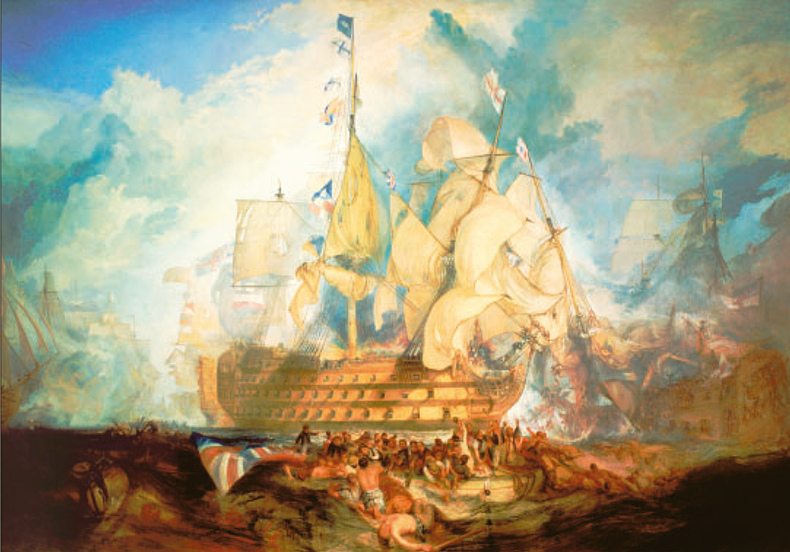
Figure 1. HMS Victory, flagship of Admiral Lord Nelson, leading the Weather Column at the Battle of Trafalgar, 21 October 1805, engaging with the Bucentaure (Admiral Villeneuve) and Redoubtable. Painting by J.M.W. Turner (1825) commissioned by King George IV for St James’ Palace and now in the National Maritime Museum, Greenwich. The foretopmast and foretopsail, which provided the subject of the restoration project and linen specimens for study here, is shown being brought down by gunfire from the Neptune. Reproduced with permission of the Curators of the National Maritime Museum, Greenwich, reference ID BHC0565.
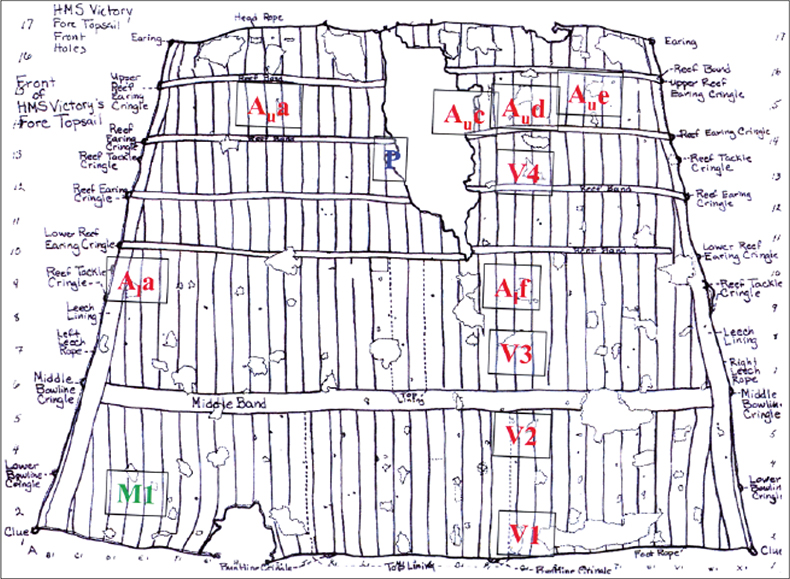
Figure 2. The foretopsail of HMS Victory from a conservator’s sketch prior to its restoration for the bicentenary celebrations in October 2005 of the Battle of Trafalgar. After the Battle of Trafalgar, the only surviving sail was put into storage; selected specimens were taken for rheological and spectroscopic analyses from the regions labelled A, V and M in the diagram. Reproduced with permission of John Wiley & Sons, J. Raman Spectrosc., Reference 7.
Raman spectroscopy
Raman spectra were recorded using a Bruker IFS66/FRA 106 Fourier transform (FT) spectrometer operating with a Nd3+/YAG laser in the near infrared at 1064 nm and minimal power at the specimen of 50 mW or less to facilitate the recording of spectra without damage to the sample.7 Spectra were recorded with a resolution of 4 cm–1 and 2000 scans were co-added to effect improved signal-to-noise ratios. The long wavelength excitation of the Raman spectra of the linen fibres was fluorescence-free, unlike excitation carried out using visible and near infrared lasers in the wavelength range 488–785 nm. Fibre specimens were provided by conservation scientists from several parts of the ancient sail, and control specimens were taken of modern sail linen at several stages during its multicyclical artificial ageing process involving elevated temperature, soaking in brine and exposure to ultraviolet radiation in the laboratory at the Textile Conservation Institute at Winchester.

Figure 3. Molecular structure of cellulose, comprising the linen sail, showing the D-glucose units with beta-1,4-glycosidic COC linkages.
Cyclical artificial ageing
Specimens of modern linen sailcloth (Banks Sails, UK) were subjected to the following sequential procedures:
- Soaking in brine for 1 h, followed by drying at 70°C for a further 1 h, repeated cyclically for one week;
- Heating to 70°C for a period of seven weeks at 100% relative humidity;
- Exposure to UV-radiation for one week with an irradiance of 200 W m–2;
- Multiple sequencing of the above operations, representing about seven complete cycles.
Fibres were then tested for tensility using an Instron 4301 equipped with a 100 N load cell at 23°C and 55% relative humidity, with an extension rate of 10 mm min–1 and selected specimens were examined spectroscopically.7
The Raman spectrum of an ancient textile linen fibre from the Victory sail can be compared with that of a modern linen Banks Sails sailcloth; the dominant features in the vibrational spectrum are those of the COC glycosidic stretching and ring stretching bands in the poly-D-glucose structure (Figure 3) of the linen. The major differences between the Raman spectra as seen in a spectral stack-plot of selected specimens shown in Figure 4, can be attributed to the degradation of the linen structure, which can occur through temperature changes, radiation fission of the beta-1,4-glycosidic linkages, oxidative fission, hydrolysis, bacterial action resulting in ring-opening, and corrosion effects on the integrity of the natural polymer.8 The resulting embrittlement of the fibre and detritus deposited can be observed in the formation of coloured mucilage and acidic debris. The average tensility of the historically aged linen fibres of the Victory sail is now only some 30% of that measured for the new sailcloth6 and this implies that the degradation of the ancient marine textile is far advanced.
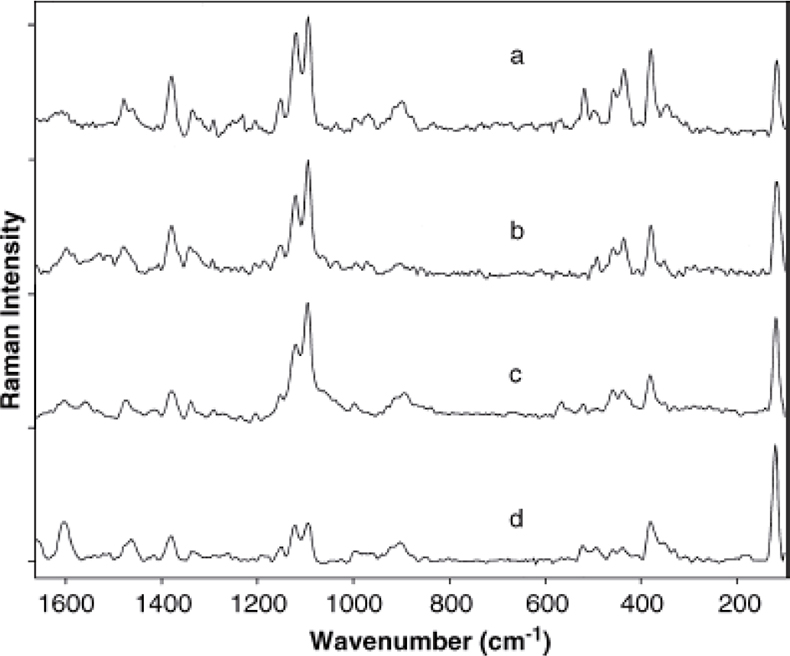
Figure 4. FT-Raman spectral stack-plot of the Victory sail linen specimens and modern replicate Banks Sails sail, 1064 nm excitation, 2000 scans accumulated, wavenumber range 100–1650 cm–1, 4 cm–1 spectral resolution; a: V1, b: V2, c: V3, d: Banks sail. The relative intensity changes between the doublet at 1122, 1097 cm–1, and the band at 120 cm–1 should be noted. The presence of jute incorporated in the modern sail linen for strength is registered by the band at 1605 cm–1, which is significantly reduced in intensity in the ancient linen samples. Reproduced from J. Raman Spectrosc., Reference 7 with permission of John Wiley & Sons.
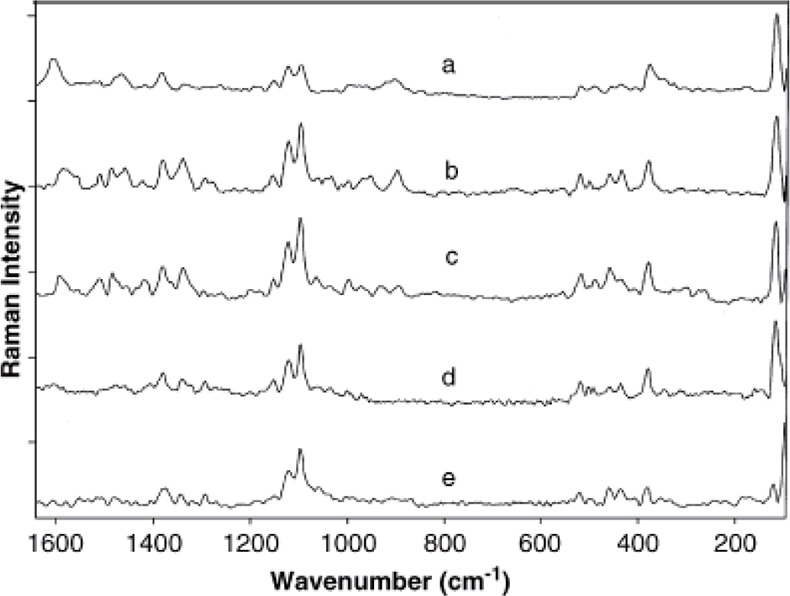
Figure 5. FT-Raman spectral stack-plot of artificially aged modern sailcloth specimens, labelled a–e, representing consecutively the unaged, brine treated, brine and light treated, brine and light and heat-treated, and brine and light and heat and light-treated specimens, respectively. Details of the ageing cycles are given in the text and the spectral conditions are as described in Figure 4. Reproduced from J. Raman Spectrosc., Reference 7 with permission of John Wiley & Sons.
Table 1. Wavenumber (cm–1) and vibrational Raman band assignments for cotton cellulose. Reproduced from J. Raman Spectrosc., Reference 7 with permission of John Wiley & Sons.
ν (cm–1) | Approximate description of vibrational mode |
172 w | τ(COH) |
252 w | τ(COH) |
333 vw | δ(CCC) ring deformation |
349 mw | δ(CCC) ring deformation |
380 m | δ(CCC) ring deformation |
437 m | δ(CCC) ring deformation |
460 mw | δ(CCC) ring deformation |
496 w | δ(COC) glycosidic linkage |
520 mw | δ(COC) glycosidic linkage |
542 w | δ(COC) glycosidic ring, in-plane |
900 mw, br | ν(COC) in-plane, symmetric |
972 w | ρ(CH2) |
999 mw | ρ(CH2) |
1026 | δ(OH) |
1038 | ν(CO), 1° alcohol groups |
1059 | ν(CO), 2° alcohol groups |
1072 | ν(CO) |
1097 s | ν(COC), asymmetric, glycosidic link |
1122 ms | ν(COC), symmetric, glycosidic link, ν(COC) ring breathing |
1153 mw | ν(CC) ring breathing, asymmetric |
1294 mw | δ(CH2) twisting |
1338 mw | δ(CH2) wagging; δ(OH) |
1380 m | δ(CH2) |
1410 vw | δ(CH2) |
1462 mw, sh | δ(COH), 1° and 2 alcohol groups |
1478 mw, br | δ(CH2) scissors |
2723 w | ν(CH) methine |
2870 mw, sh | ν(CH2) |
2894 s | ν(CH2) symmetric and asymmetric |
2910 m, sh | ν(CH2) |
2948 mw, sh | ν(CH2) |
2957 mw, sh | ν(CH2) |
2970 mw | ν(CH2) |
3270 w, br | ν(OH), COH groups, hydrogen-bonded |
We have previously identified vibrational spectroscopic features in the Raman spectra of linen specimens, which can be assigned to the major functionalities associated with the cellulosic structure; assignments are given in Table 1. In addition, several bands can be ascribed to the addition of jute, which was combined with linen to strengthen the weave; a good example that can be seen in the Raman spectrum of the modern linen is the aromatic quadrant-stretching band at 1605 cm–1, which is assignable to the phenolic lignin component of jute. Although this feature is not observed in the comparative spectra of some ancient archaeological linens, such as those analysed from ancient Egyptian Dynastic burials,8 it is seen here at much reduced intensity in the stack-plotted spectra of the historic sail, which could reflect either a smaller jute content or probably the destruction of the lignin component in the ancient sail consequent upon its oxidative and radiation-induced degradation over two centuries of use and storage.
Figure 5 gives an example of the effect of the cyclical ageing experiments upon the observed Raman spectra of modern Banks Sails sail linen fibres. Of particular interest is the lower spectrum (e), which represents the accumulation of the extreme conditions imposed by the multiple cyclical simulated ageing processes carried out in the laboratory and which is considered to be a very close match for the spectra of the specimens of historical linen taken from the Victory sail. The laboratory extreme specimen, resulting from the combination of ageing cycles involving heat, dehydration, brine saturation and radiation exposure on modern linen fibres also afforded specimens that exhibited similar decreased tensility to those observed for the historical specimens and gave similar Raman spectra to that shown in Figure 5(e). Some significant relative intensity changes can be seen in this spectral stack-plot, which clearly reflect the progressive degradation of the cellulose biopolymer; in particular, attention can be drawn to the relative intensities in the components of the doublet at 1122 and 1097 cm–1 and the ratio of the intensities of this doublet and the band at 120 cm–1.
For a more detailed discussion of the band assignments and relative intensity changes reference should be made to the primary literature.7,8
Conclusions
The application of Raman spectroscopy to the characterisation of an important ancient historical, degraded marine textile enabled the appropriate restorative procedures to be adopted for its sympathetic conservation and preservation. In this example, the combination of the natural damage resulting from environmental exposure over two centuries and deliberate battle damage provided a particularly challenging test for the viability of spectroscopic monitoring in conservation science. Several other applications of spectroscopic monitoring of degradation in the area of historic textile conservation can be envisaged with different challenges, especially for discoloured and deteriorated dyed fabrics in museum collections and for the forensic archaeological evaluation of textiles from burial sites and excavations, for example, the presence of partially degraded textiles adjacent to and in contact with chemicals used in funerary procedures and in grave sites would be an interesting and useful extension to the spectroscopic forensic database.
Acknowledgements
The author would like to record his gratitude to Dr Paul Wyeth of the Textile Conservation Institute, University of Southampton at Winchester, Lt Cdr Frank Nowosoielski, Commanding Officer of HMS Victory, Peter Goodwin, Keeper and Curator of HMS Victory, Mark Jones, Head of Collections, The Mary Rose Trust, for the provision of the historic samples of the foretopsail of HMS Victory. Also, the invaluable contribution of doctoral research student Nik Nikhassan and Paul Garside, Research Fellow at the AHRC Research Centre for Textile Conservation and Textile Studies, to the detailed investigation of linen degradation is acknowledged. The permission of The National Maritime Museum, Greenwich, for the reproduction of J.M.W. Turner’s painting of HMS Victory “breaking the line” at the Battle of Trafalgar is also gratefully acknowledged.
References
- H.G.M. Edwards and J.M. Chalmers (Eds), Raman Spectroscopy in Archaeology and Art History. Royal Society of Chemistry Publishing, Cambridge (2005).
- E. Ciliberto and G. Spoto (Eds), Modern Analytical Methods in Art and Archaeology. Wiley, New York (2000). https://doi.org/10.1006/rwsp.2000.0003
- H.G.M. Edwards, “Art works studied using IR and Raman spectroscopy”, in Encyclopedia of Spectroscopy and Spectrometry, Ed by J.C. Lindon, G.E. Tranter and J.L. Holmes. Academic Press, London, pp. 2–17 (1999).
- G.D. Smith and R.J.H. Clark, Revs. Conservation 2, 96 (2002).
- W.L. Clowes, Royal Navy: A History from the Earliest Times to 1900, 1st Edition. Chatham Publishers, London (1996).
- P. Garside and P. Wyeth, Assessing the Physical State of the Foretopsail of the HMS Victory. Postprints of the First Annual Conference, AHRB Centre for Textile Conservation and Textile Studies, Winchester, 13–15 July (2004).
- H.G.M. Edwards, N.F. Nikhassan, D.W. Farwell, P. Garside and P. Wyeth, J. Raman Spectrosc. 37, 1193–1200 (2006). https://doi.org/10.1002/jrs.1609
- H.G.M. Edwards, E. Ellis, D.W. Farwell and R.C. Janaway, J. Raman Spectrosc. 27, 663–669 (1996). https://doi.org/10.1002/(SICI)1097-4555(199609)27:9<663::AID-JRS11>3.0.CO;2-E










